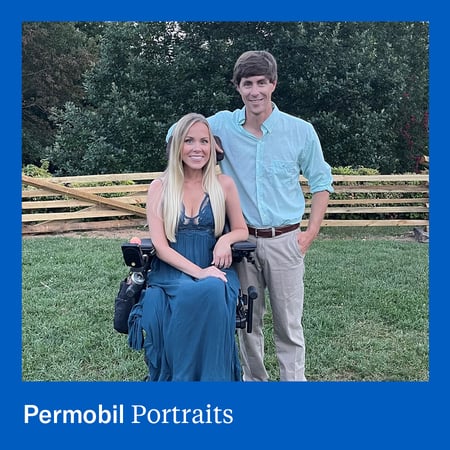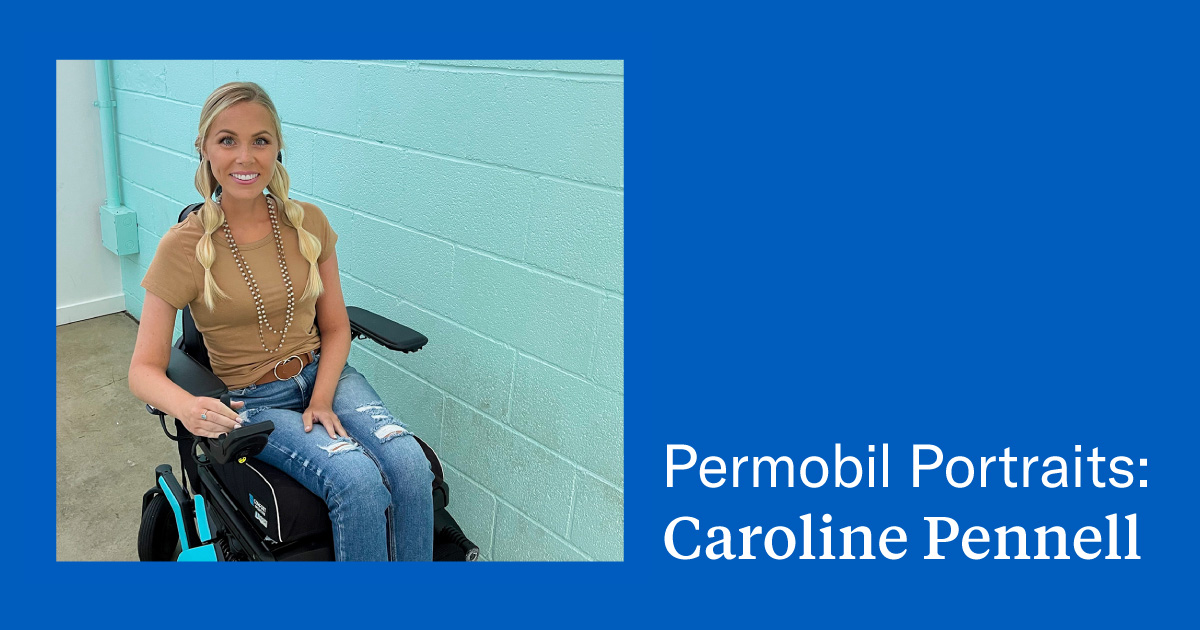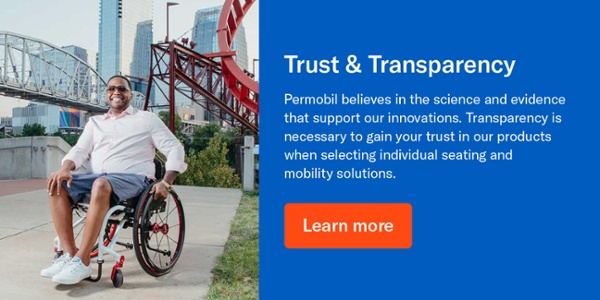Nothing excites Caroline Pennell more than beachcombing on the weekends and uncovering the treasures washed ashore – especially sharks ’teeth, sea glass, and the occasional arrowhead. In addition to her love of the ocean, this Virginia native is the proud mother of two adorable long-haired dachshunds, River and Buoy.
As a young child Caroline was extremely active. Then at the age of 9 she began experiencing a change in her physical abilities and soon after she was diagnosed with Limb-Girdle Muscular Dystrophy Type 2D and in her words her “childhood kind of ended.” But a few years later while attending her first MDA camp her entire perspective on life and her diagnosis changed.
We are honored to have Caroline share her story with us in this Permobil Portrait!
What was your childhood like?
I grew up in Chesterfield County, Virginia, a suburb just south of Richmond with my parents and older brother. According to my parents I was a happy, healthy baby who hit all my milestones on time. From an early age I was super active. You name it, I was in it. I did competitive horseback riding, cheerleading, soccer, gymnastics, and dance. I loved being competitiveness of it all.
My parents have been together for 34 years and have always been great role models. Every summer growing up we went with my dad’s family to Litchfield Beach, South Carolina. It’s always been one of my favorite places because where we stayed was the best of both worlds— the beach on one side and the inlet on the other side. We could do everything from play on the beach to fish and crab.
The Virginia Tech Hokies and South Carolina Gamecocks have also always been a part of my life. My family and I look forward to college football season every year!
When were you diagnosed with muscular dystrophy?
I was diagnosed with Limb-Girdle Muscular Dystrophy Type 2D (LGMD2D) at 9 years old. Even though it is a genetic disease, nobody on my mom or dad’s side of the family had any history of this disease. LGMD2D is caused by a mutation in a recessive gene that both parents must have and if both parents do carry the mutation there is only a 25% chance of the parents having a child with LGMD2D.
We had no idea there was anything “wrong” with me until one day my school bus driver pulled my mom aside to let her know she had noticed I had trouble climbing the stairs onto the bus and wondered if there was something wrong with my back. Initially, my mom got a little bit defensive, pointing out to the driver that I was small for my age and carrying a backpack full of big books. But then after that for about a week my mom followed me to watch me get on and off the bus. I believe that was also about the time she started writing notes about things she noticed, such as me walking on my tippy-toes, crawling up the stairs, and how I was getting up from the floor – called the Gower’s maneuver. Around that same time, my gym teacher also reached out to my mom saying she noticed stuff too. But what really pushed my mother over the edge of being certain something wrong was when I faked sick to get out of having to go to school to participate in the PACER test. I put a hair dryer to my forehead to make it warm and lied to my mom about not feeling well, because I didn’t think I could do it and didn’t want to embarrass myself. But, I felt so bad about faking sick that I ended up coming clean and confessing to my mom. She took me up to the school to practice running the bus loop and somehow, I did it under the time, but my endurance was low. After that, my parents decided it was time to call my doctor.
The following week I remember we went to see my pediatrician. We went through all the usual physical and mental tests. The doctor told my mom I was fine, at which time my mom asked the doctor to watch me get up off the floor. After watching me do it, my doctor agreed to take some of my blood to test. I very distinctly remember about two or three days later as I got out of my carpool at home, I saw my parents were there along with a car I didn’t recognize in our driveway. As I went inside, my parents were sitting on the couch talking to my doctor. He showed up at our house and told my parents I had a type of muscular dystrophy and I needed to be seen at the Children’s Hospital of Richmond for more tests to figure out which type. At that point we didn’t really know what muscular dystrophy even meant.
So, I went to see the doctor my primary doctor had recommended. Apparently, the specialist was watching me walk back to the exam room when they called me back, because she walked into the room and almost immediately said she could tell from my gait pattern that I had a type of Limb-Girdle Muscular Dystrophy. She was just like boom, boom, boom, on the spot with everything I needed to do next, starting with setting up a muscle biopsy to determine the exact subtype I had. She was just throwing all this information out and we were still kind of shell-shocked and feeling overwhelmed. My parents definitely wanted to know the exact subtype. But I felt like I could’ve done without knowing everything. It’s incredible how 4 words can shatter your childhood— or at least the life you thought you would have.

Caroline with her brother
What happened after you were diagnosed?
I was adamant that I didn’t want anyone to know about my diagnosis and I told my parents not to tell anybody. Which, looking back, was a really big ask of them. But I didn’t want sympathy or to be treated differently. It was very isolating and difficult. All the sports and activities I was in pretty much ended immediately. I felt a wedge come between me and the group of friends I had grown up with because of that withdrawal from sports teams and not confessing why I dropped. I just kind of vanished, so I wouldn’t have to tell them. It was just a weird time for me. At that point in time there wasn’t really any physical change in my life except for my diagnosis.
By the time I got into middle school, I noticed I was getting weaker. I was having a harder time walking, I needed to sway back a little bit to keep my balance and was falling a lot and having a hard time getting back up. For the first time I needed to have an aide and other accommodations at school, which made it hard to hide my diagnosis.
Stay tuned for the next chapter of Caroline's journey, where we'll dive deeper into her experiences in high school and college, the pivotal moments that shaped her perspective on her diagnosis, and the passions that drive her forward. Don't miss out on the interesting story of this remarkable individual.
 Angie Kiger, M.Ed., CTRS, ATP/SMS
Angie Kiger, M.Ed., CTRS, ATP/SMS
Portfolio Marketing Manager
Angie Kiger, M.Ed., CTRS, ATP/SMS earned a Master of Education degree in Assistive Technology from George Mason University. She is an Assistive Technology Professional (ATP), Seating and Mobility Specialist (SMS), and a Certified Therapeutic Recreation Specialist (CTRS). Angie has over 20 years of experience working in the field of assistive technology serving infants, children, and adults in inpatient, outpatient, school, and community settings with a variety of diagnoses. In addition to working as a clinician, Angie has served as an adjunct instructor at George Mason University and presented hundreds of clinical education trainings both in-person and virtually for global audiences. She has written articles for trade publications and been involved in clinical research. Angie is a member of and serves on the executive board for the nationwide advocacy group The Clinician Task Force. She joined Permobil Americas in mid-2022.

